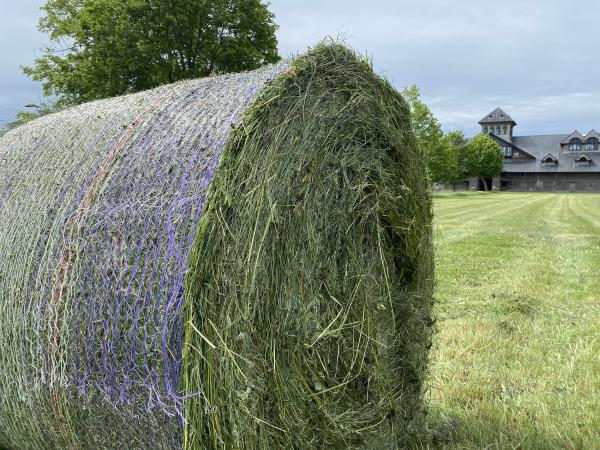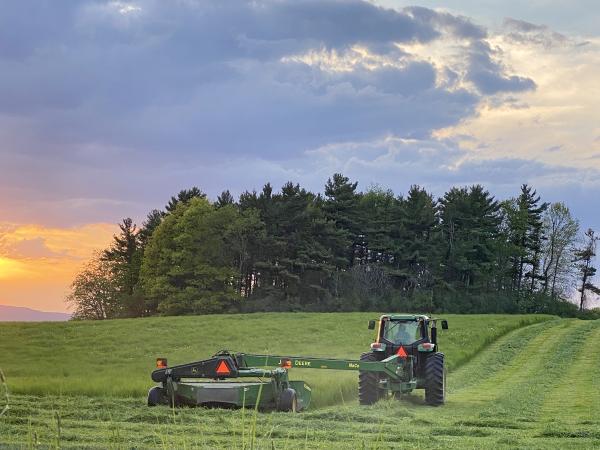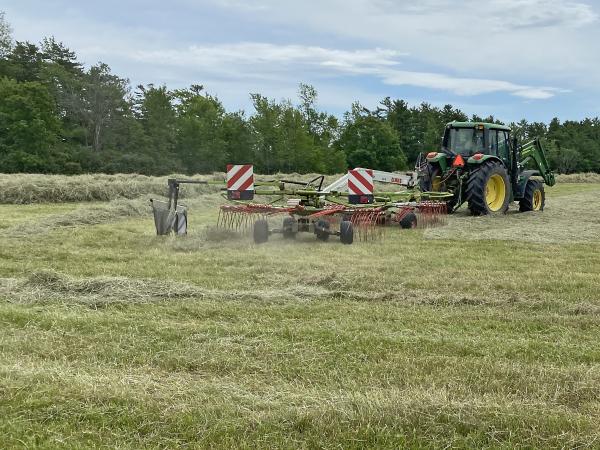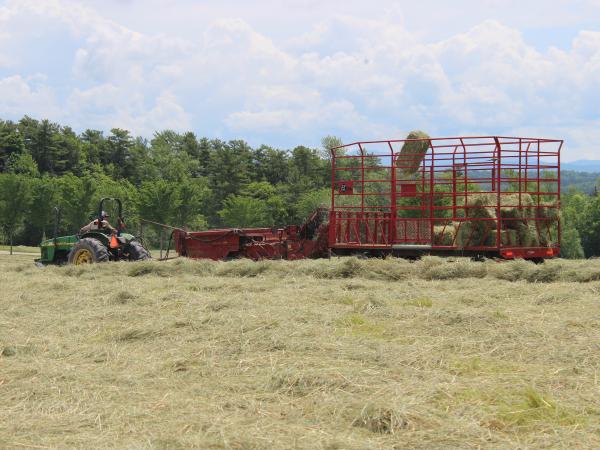This is great!
There’s never a quiet time of year for dairy farmers, but haying season can be especially busy. As the saying goes, “You have to make hay while the sun shines!” Haying may seem pretty straightforward, but to do it well, you need an intimate knowledge of your soils, plants, and animals.
Here are the basics.
The Fields
Not every expanse of green on the farm is the same.
Pastures: Pastures are for grazing cows (or sheep). No tractors are needed; the cows do the harvesting directly. We “rotationally graze” our milking cows: We fence them in a small pasture area for a short amount of time to graze, then move them to a new space, giving plants in the first area time to grow back strong and vigorous before being grazed again. Rotational grazing yields nutritious pastures, controls water runoff, supports soil biodiversity, and stores soil carbon. It’s one way we practice regenerative agriculture. (There's a lot more to say about grazing, but that's for another blog.)
Hay Fields: We use tractors to harvest 600 acres of fields for hay. (The dairy team has a name for each field, like East Ditch field, Greenhouse Barracks, and Lower Windmill.) Field productivity varies depending on the underlying soils or whether manure is spread on them in season, and this affects when and how we harvest each one. Productive fields may be hayed several times a season, less productive ones only once.
Some fields get both mowed and grazed: In the spring, our cows often can’t keep up with fast-growing pastures. Instead of letting this good forage go to waste, we’ll harvest it with a tractor to store for the winter, then let cows graze these pastures later in the season.
The Harvest
Haying basically involves four steps: Mowing (or cutting), tedding, raking, and baling.
1. Mowing: Mowing fields is like mowing your lawn, except the grasses get taller in between mowings (and we use different equipment!). In a good growing season, a single field can be cut several times.
Generally, the first cut happens in May. It usually is the most nutritious harvest because of the rich spring growth. A second cut is often taken in late June or July. As summer wears on, forage grows more slowly, but with a bump in September, so many fields will support a third cut, and occasionally even a fourth.
Our farm has 250 acres of hayfields (out of 600), that support breeding populations of grassland birds. To protect these birds, we adjust our normal cutting schedule: we take a first cut early, then delay a second cut for 65 days. This gives the bobolinks and savannah sparrows time to nest, hatch, and fledge their young.
2. Tedding: Once hay is on the ground, it needs time to dry so it won’t mold or spoil. Tedding fluffs up the cut hay to help it dry better. (If we’re making silage, we skip tedding because we want to wrap up the plants before they’re too dried out. More on this below.)
3. Raking: We pull the cut hay into rows (“windrows”) so it’s easier to bale.
4. Baling: You can store hay as round bales or square bales(the hay is the same), depending on a farm's needs and resources. We make both. Each requires different baling equipment.
In our system, making round bales for silage is a two-step process. First we bale the cut pastures (above).
Then we tractor the bales to a couple of central areas on the farm, where they are tube wrapped (seen here). More on tube wrapping below.
The Products
Our hay fields include plants like timothy, brome grass, orchard grass, and clovers. We tractor-harvest them for two different "products":
Dry hay: High quality dry hay is used for feed; lower quality hay is for bedding. We cut and stored both round bales and square bales. We make round bales for our dairy cows; and square bales primarily for our Children’s Farmyard animals. That’s partly because of storage space: the square bales have to be lifted into the hay mow above the Farmyard!
Silage: Silage is animal feed only. Plants are cut at their highest quality—fresh and moist—then quickly rolled and wrapped in plastic so that they ferment inside. This harvest and storage method yields feed that is higher in protein and easier to digest than dry hay. It’s a valuable feed for our cows through the winter, in addition to their grain supplement. In our system, we wrap our bales into long plastic tubes, which uses 30% less plastic than wrapping each bale individually.
There’s an old saying in the farming community, “A wet May fills the barns with hay.” That has certainly been true this year. A normal first cut yields about 2 bales/acre. With our first cut, the yield was 5-6 bales/acre. As Farm Manager Sam Dixon says, “we got the right amount of rain at the right time.”
Harvesting hay and baleage, and pasturing our cows and sheep, are essential to our sustainable farming system. They allow us to make high quality feed for our cows, to create a beautiful working landscape, and to maintain a nutritional balance on our farm: the nutrients taken from the land through haying and grazing are returned to the land by our cows and sheep. Understanding the basics of farming and how it’s done makes all of us better able to make decisions about the food we eat.
Comments
Beautifully written and very informative. Thank you for making the explicit connection to regenerative farming practices. Bless you for finding ways to reduce the amount of plastic for the silage. It all matters and it all adds up.
I love to read and learn about Sustainable Agriculture and observe it on my walks . Really feel lucky to enjoy this beautiful farm and landscape. Thanks.
Got to this page as an author writing a story... very informative, and wonderful pictures. Thanks for putting this together. :)




